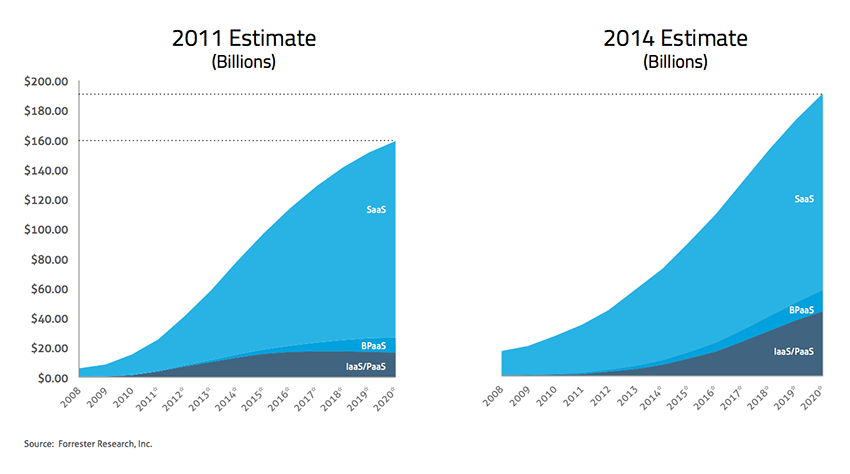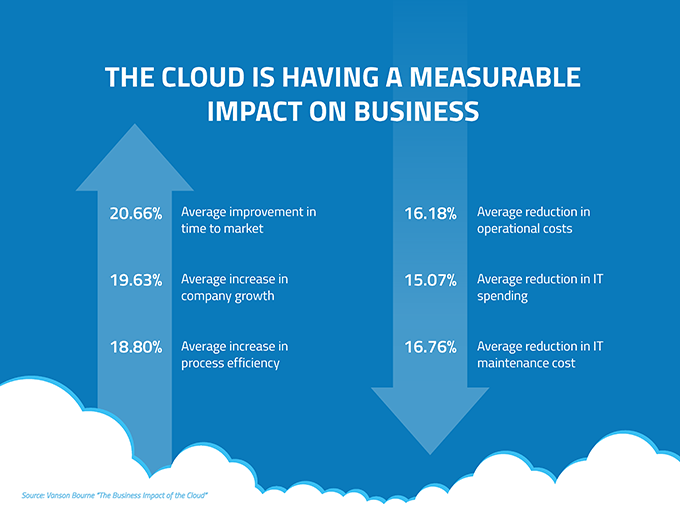While their motivations vary, businesses of all sizes, industries, and geographies are turning to cloud services. According to Goldman Sachs, spending on cloud computing infrastructure and platforms will grow at a 30% compound annual growth rate (CAGR) from 2013 through 2018 compared with 5 percent growth for overall enterprise IT, giving rise to the CASB market in the process. Cloud adoption is accelerating faster than previously anticipated, leading Forrester to recently revise its 2011 forecast of the public cloud market size upward by 20 percent. Whether you’re looking at Software-as-a-Service (SaaS), Infrastructure-as-a-Service (IaaS), or Platform-as-a-Service (PaaS), the predictions are the same: fast growth of the workloads placed in the cloud and an increased percentage of the total IT budget going toward cloud computing.
 According to a study by the Cloud Security Alliance, 33% of organizations have a “full steam ahead” attitude toward cloud services and 86% of companies spend at least part of their IT budget on cloud services. IT leaders at 79% of companies receive regular requests from end users each month to buy more cloud applications with file sharing and collaboration, communication, social media, and content sharing topping the list of the most-requested cloud services.
According to a study by the Cloud Security Alliance, 33% of organizations have a “full steam ahead” attitude toward cloud services and 86% of companies spend at least part of their IT budget on cloud services. IT leaders at 79% of companies receive regular requests from end users each month to buy more cloud applications with file sharing and collaboration, communication, social media, and content sharing topping the list of the most-requested cloud services.
Cloud Adoption Report
Numerous factors are driving cloud adoption, according to a study conducted by the market research company Vanson Bourne. “The Business Impact of the Cloud” report compiles insights from interviews of 460 senior decision-makers within the finance functions of various enterprises. The report summarized 11 drivers of cloud adoption along with quantifiable improvements these companies have achieved by deploying cloud services to improve productivity, lower cost, and improve time to market.
Though they aren’t in IT positions, the majority of these financial executives are actively involved in their organizations’ discussions about cloud strategy. Their perspective of cloud computing includes benefits to the business as a whole. Companies that adopted cloud services experienced a 20.66% average improvement in time to market, 18.80% average increase in process efficiency, and 15.07% reduction in IT spending. Together, these benefits led to a 19.63% increase in company growth.

The Vanson Bourne report identified eleven advantages of cloud computing that organizations are experiencing today, leading to quantifiable improvements in their businesses:
1. Flexibility
Cloud-based services are ideal for businesses with growing or fluctuating bandwidth demands. If your needs increase it’s easy to scale up your cloud capacity, drawing on the service’s remote servers. Likewise, if you need to scale down again, the flexibility is baked into the service. This level of agility can give businesses using cloud computing a real advantage over competitors – it’s not surprising that CIOs and IT Directors rank ‘operational agility’ as a top driver for cloud adoption.
2. Disaster recovery
Businesses of all sizes should be investing in robust disaster recovery, but for smaller businesses that lack the required cash and expertise, this is often more an ideal than the reality. Cloud is now helping more organisations buck that trend. According to Aberdeen Group, small businesses are twice as likely as larger companies to have implemented cloud-based backup and recovery solutions that save time, avoid large up-front investment and roll up third-party expertise as part of the deal.
3. Automatic software updates
The beauty of cloud computing is that the servers are off-premise, out of sight and out of your hair. Suppliers take care of them for you and roll out regular software updates – including security updates – so you don’t have to worry about wasting time maintaining the system yourself. Leaving you free to focus on the things that matter, like growing your business.
4. Capital-expenditure Free
Cloud computing cuts out the high cost of hardware. You simply pay as you go and enjoy a subscription-based model that’s kind to your cash flow. Add to that the ease of setup and management and suddenly your scary, hairy IT project looks at lot friendlier. It’s never been easier to take the first step to cloud adoption.
5. Increased collaboration
When your teams can access, edit and share documents anytime, from anywhere, they’re able to do more together, and do it better. Cloud-based workflow and file sharing apps help them make updates in real time and gives them full visibility of their collaborations.
6. Work from anywhere
With cloud computing, if you’ve got an internet connection you can be at work. And with most serious cloud services offering mobile apps, you’re not restricted by which device you’ve got to hand.
The result? Businesses can offer more flexible working perks to employees so they can enjoy the work-life balance that suits them – without productivity taking a hit. One study reported that 42% of workers would swap a portion of their pay for the ability to telecommute. On average they’d be willing to take a 6% pay cut.
7. Document control
The more employees and partners collaborate on documents, the greater the need for watertight document control. Before the cloud, workers had to send files back and forth as email attachments to be worked on by one user at a time. Sooner or later – usually sooner – you end up with a mess of conflicting file content, formats and titles.
And as even the smallest companies become more global, the scope for complication rises. According to one study, “73% of knowledge workers collaborate with people in different time zones and regions at least monthly”.
When you make the move to cloud computing, all files are stored centrally and everyone sees one version of the truth. Greater visibility means improved collaboration, which ultimately means better work and a healthier bottom line. If you’re still relying on the old way, it could be time to try something a little more streamlined.
8. Security
Lost laptops are a billion dollar business problem. And potentially greater than the loss of an expensive piece of kit is the loss of the sensitive data inside it. Cloud computing gives you greater security when this happens. Because your data is stored in the cloud, you can access it no matter what happens to your machine. And you can even remotely wipe data from lost laptops so it doesn’t get into the wrong hands.
9. Competitiveness
Wish there was a simple step you could take to become more competitive? Moving to the cloud gives access to enterprise-class technology, for everyone. It also allows smaller businesses to act faster than big, established competitors. Pay-as-you-go service and cloud business applications mean small outfits can run with the big boys, and disrupt the market, while remaining lean and nimble. David now packs a Goliath-sized punch.
10. Environmentally friendly
While the above points spell out the benefits of cloud computing for your business, moving to the cloud isn’t an entirely selfish act. The environment gets a little love too. When your cloud needs fluctuate, your server capacity scales up and down to fit. So you only use the energy you need and you don’t leave oversized carbon footprints.


